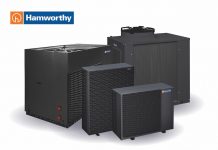
Convergence of generation and consumption of energy is happening now and structural shifts within the energy system will start to have a more direct bearing on profit and loss.
That requires businesses to break down internal silos to remain competitive in a rapidly changing landscape, according to Rob Williams, BT’s head of procurement for property, FM, power & cooling and utilities.
Talk business, not energy
Williams believes energy managers will be pivotal in effecting change, but must communicate business outcomes rather than talk about energy, which few executives fully understand, or care much about.
Williams’ lengthy job title suggests BT has grasped the nettle. He told delegates at The Energyst Event that BT’s departments have been collaborating, or converging, for a number of years to cut emissions and consumption, setting its first carbon target in 1992.
He cited BT’s Home Hub by way of example.
“We introduced ‘spring out’ feet on the Home Hub in 2014. The product R&D team initially didn’t want to do that, because it made the hub more expensive. But it meant we could package it in an envelope that fitted through letterboxes, which means delivering first time, first journey. That saves cost, carbon and time and improves customer service.”
BT operates 80,000 meter points. Using their data to inform carbon targets, Williams said the company determined that 67% of its end-to-end emissions are actually within its supply chain, not its own operations.
Communicating such data, and its business implications throughout the company, is critical to reducing its footprint and driving commercial outcomes, said Williams.
But there’s the rub.
“That is one of the real challenges of energy management, and all technical disciplines; to communicate to finance and the CEO what on earth are you actually talking about,” said Williams.
“Talking in kilowatts and megawatts doesn’t turn anybody on; doesn’t create any investment plan. To really engage with finance, and drive collaboration and convergence, we have to talk simply as an industry,” he said. “A problem clearly put is a problem half solved.”
No more silos
Williams said he has been able to join the dots at BT due to broad experience within the energy sector, and now trains energy managers in technical disciplines via the Energy Institute’s advanced energy manager course. But tutors also underline the importance of effective communication.
“If you can’t communicate with your CFO, I always tell attendees, then you are probably going to fail as an energy manager,” said Williams
“My background is wind farm development, selling electricity to utilities via PPAs (power purchase agreements, where buyers agree a set price for power directly with a developer or generator),” Williams explained.
“Then I moved downstream to join one of the UK’s largest energy consumers, first in operations department, in the energy management team, then into procurement.”
The benefit of that experience, he said, has helped drive convergence and efficiencies within BT, which now buys around 400GWh per annum directly from wind farms, and has an 8.2MW solar farm connected directly to its Ipswich R&D hub.
That means the company can better manage electricity costs as well as reduce emissions.
Taking a joined-up approach across property, FM, power and cooling and utilities, is delivering further bottom line benefits, according to Williams.
Combining procurement across those areas “feels natural” in hindsight, he said. “But in big business, we act in silos. Getting people to act across those silos is really challenging. Convergence internally can be as difficult as the convergence externally, particularly when some parts [of the business] are outsourced,” he said.
The first step was to combine utilities procurement with power and cooling. “That got the teams talking together” and resulted in a shift from procurement based on capital expenditure (capex, focusing on lowest upfront cost), to operational expenditure (opex, focusing more on whole life costs), said Williams.
“That sounds simple, but for many businesses, can be a massive change.”
Williams gave an example of the capex to opex shift at its data centres, where BT is investing in adiabatic cooling, which uses water and air to cool plant rather than refrigerant gases, so is more environmentally friendly and delivers lower running costs.
Next steps: IoT
Williams believes BT has one of the largest Buildings Management Systems in the country, with 6,000 buildings connected to the system. The next step is to add further sensors and comms infrastructure throughout the estate to deliver greater efficiency through smarter controls.
But Williams suggested a unified approach to energy and property is as critical as the underpinning infrastructure.
“Looking at the business case for the internet of things (IoT), you are not just looking at energy, or power and cooling,” said Williams, “you also have quotes in there where people are talking about 20% saving on cleaning – that is FM,” he explained.
“We have brought property and FM under my management because of all the linkages between those areas. Lighting is traditionally an FM product, not a hard technical M&E prod. But IoT starts to naturally merge these things: [unlocking] 20% savings on cleaning; 10% savings on energy; 20% savings on M&E maintenance,” said Williams.
“One system covers all of those elements. So if you are buying an IoT system, you need to converge the thinking and the themes.”
Communicate and collaborate
Communication is critical in delivering such ambitious change, Williams reiterated.
“Energy managers need to help the business and finance communities understand their future energy costs and the drivers of those costs,” he said. “Whether that is transmission and distribution costs, increasing Renewables Obligation or Feed-in Tariff costs, or future Contracts for Difference costs, as well as what is driving consumption,” said Williams.
“Convergence of generation and consumption is really happening, and it is critically important that businesses understand [the implications].”
Williams cited two examples of energy managers contributing to forward business planning, one internal and one external:
“We were running a [data] back-up at 5pm in one of our data centres. Somebody realised that was in a red band for DUoS charging [the most expensive period for distribution network charges],” said Williams. “Moving that to overnight saved £50,000 per year. That is a really simple example, but lots of people still don’t know what a DUoS red band is.”
The second example related to a factory in the North East, which similarly sought to avoid peak network costs by shutting down at 4pm rather than consume power into the evening peak period.
“They worked with the HR team to come up with a bonus scheme for all the employees to change the shift patterns. All the workers were paid a bonus – and that paid back in 18 months,” said Williams. “That is a great example of how HR, cost and energy can all come together to make business more efficient.”
“That is convergence, and it is where energy managers need to be.”
Related stories:
BT energy chief: data scientists are the future of energy management
Tim Rotheray: Change is coming and passive energy users will feel pain
Ofgem chief relishes “difficult, contentious” charging review
Ofgem paves way for major charging changes
Clean growth plan asks firms to make 20% energy efficiency gains
Click here to see if you qualify for a free subscription to the print magazine, or to renew.
Follow us at @EnergystMedia. For regular bulletins, sign up for the free newsletter.



